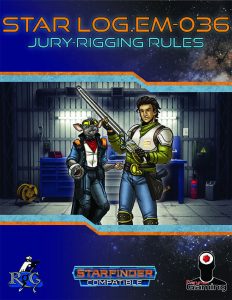Star Log.EM: Jury-Rigging Rules (SFRPG)
Star Log.EM: Jury-Rigging Rules (SFRPG)

#10 of my Top Ten of 2018
This installment of the Star Log.EM-series clocks in at 7 pages, 1 page front cover, 1 page editorial, 2 pages of SRD, leaving us with 3 pages of content, so let’s take a look!
After a brief and flavorful introduction, we begin with one of the most-requested components in SFRPG; a staple of particularly grittier scifi/science-fantasy, and something I *really* wanted to see: Rules to jury-rig items. A handy table collates objects and related skills – and these skills can be sued to temporarily fix broken or destroyed objects. A successful skill check allows you to temporarily ignore the broken condition, with skill checks that are particularly successful increasing the duration that the item retains its fully operational status. Failing the check by 5 or more, however, risks destroying an item and preventing further attempts at jury-rigging it. Suffice to say, no taking 20, and skill checks to jury-rig can’t be made untrained. It usually takes 10 minutes to jury-rig an item, but this can be hastened – the check is penalized when doing so, though. Cool: Items you crafted actually can be jury-rigged faster! The rules also make use of item levels in a smart manner: You can only jury-rig items whose item level does not exceed the skill ranks in the associated skill, and item level also governs the DC to jury rig the respective item. Kudos for catching what could have wrecked the whole rules-complex: You can’t jury-rig items that are expended as part of their use – and yes, the pdf does cover augmentations etc. and provides two choices for the GM to deal with this. Either prohibiting it, or allowing it.
Beyond jury-rigging, the pdf also presents rules for improvising an item, generating makeshift versions of the normal iterations; this process, though, is dangerous, and the higher the item level, the more damage you risk suffering on a failure. And yes, damage types are actually codified for this damage! Failing to improvise an plasma weapon will inflict E & F damage, for example. You also require proper material, and here, the freedom of pen & paper rpgs is in full swing: Improvise cryo weapons from your fridge, fire from gasoline etc. – really cool! Precisely codified, and yet wide open to reward player creativity, and, you know, ROLEplaying! Two thumbs up! Once more, the rules cover items that would be abused and specifically exempts them from being created this way. Both are properly codified.
Mechanics get two new 2nd level tricks: Expert rigger lets you quicken jury-rigging, and further hasten the process to be viable in combat, but at the requirement of Resolve expenditure. Hybrid rigger basically makes Engineering your go-to skill for all jury-rigging and improvising. There also are 2 8th level tricks: Haphazard weaponry allows you to have your makeshift weapons fall apart on a critical hit as part of hitting, destroying the weapon. If you do, you max the weapon die damage inflicted – provided the opponent doesn’t succeed a Fortitude save, in which case, you have to roll damage as normal. Master rigger makes your makeshift and jury-rigged items last indefinitely and allows you to repair them with the appropriate skill use.
The pdf also contains two new magic hacks: Improvise Ampoule lets you invest spell energy in soda/beer cans etc. by investing spell slot to make spell ampoule. And yep, thankfully, they can’t be hoarded. Reconfigure item allows you to expend spell slots to enhance the makeshift item. there is a minor type here that is a bit confusing: “To use this ability, you must expend a spell slot with a spell level that is equal to or less than the spell slot’s spell level × 3.” That’s supposed to be “[…] than the item’s item level x3.” We also get a new 1st-level technomancer spell, integrity field, which speeds up jury-rigging, as well as providing a bonus to skill checks to do so. Additionally, you can discharge the spell in order to reduce the damage inflicted on the targeted item. Really cool: Via Resolve expenditure, you can make an item just BARELY hold together at 1 Hit Point. This is so iconic and immediately brings to mind a dozen of iconic scenes that the rules now allow you to have.
Conclusion:
Editing and formatting re top-notch on a formal level; on a rules-language level, the pdf is meticulously precise, with the exception of aforementioned glitch. Layout adheres to the series’ two-column full-color standard, and the pdf comes with a nice artwork. It has no bookmarks, but needs none.
David N. Ross’ jury-rigging rules are meticulous, precise – and, most of all: FUN. Yes, allcaps. They close a hole in SFRPG’s rules-chassis and allow groups to do cool new things, GMs to create exciting encounters, and, most of all, provide some genuinely creativity-rewarding ROLEplaying options without compromising the integrity of the rules. In short, this is frickin’ inspired and should be taped into the core-rules. The one hiccup is slightly annoying, but not enough to deprive this of the honors it should have: This gets 5 stars, my seal of approval, is a candidate for my Top Ten of 2018, and being an expansion of SFRPG’s rules that I desperately wanted to see, it also gets my EZG Essentials tag, denoting that it should be considered to be a must-own expansion for the game.
You can get this brilliant little piece of narrative gold here on OBS!

Endzeitgeist out.
